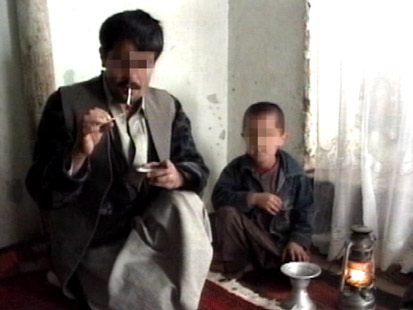Exclusive: Skyrocketing Heroin, Opium Use Ensnaring Afghan Children
State Department Finds Kids' Exposure to Drugs Could Create 'Whole Generation' of Addicts in Afghanistan
By MATTHEW MOSK and BRIAN ROSS
Apr. 20, 2010 —
Staggering levels of opium and heroin have been detected in Afghan children as young as 14 months by a team of researchers hired by the US State Department, revealing a fast-emerging problem that could cripple American efforts to bring stability to the war-torn country.
"I think we've opened a can of worms," said Bruce Goldberger, one of the University of Florida scientists heading up the study, who spoke exclusively with Brian Ross for a report airing on World News with Diane Sawyer and Nightline tonight. "This was just totally unexpected. No one has ever seen this type of exposure in young children. It's never been documented. And it's laying a foundation for drug abuse for a whole generation."
This first-ever look at household exposure to opium and heroin is not yet complete, but State Department officials and contractors shared preliminary findings exclusively with ABC News in hopes of drawing attention to a problem they say has been largely overlooked. The researchers said what they uncovered is both shocking and tragic.
Their field testing of homes of known drug users found that small children, even infants, have been passively exposed to heroin and opiates by the adult users in their homes. Some have inhaled dangerous quantities of second-hand smoke. Others have ingested traces of the drugs settling all around them -- coating their pillows and blankets and leaving a film atop carpets and furniture.
The chronic exposure is leading to levels of addiction rarely seen in children so young, the researchers told ABC News. If the problem is left unaddressed, they said, the consequences could be dire.
"This is a doomed generation of children," Goldberger said. "These children are classic opium or heroin addicts. They crave the drug. If the drug is withdrawn, they go through withdrawal."
Goldberger said he believes similar levels of narcotics in the bloodstream of pregnant women may help explain why Afghanistan has one of the highest rates of infant mortality in the world.
How many children are affected is not known. U.S. officials said 2005 estimates that there are 900,000 drug users among Afghanistan's 30 million people are outdated – and that the numbers of heroin and opium users in particular have grown dramatically. So far, the samples collected by teams of American scientists have only been focused on answering the question of how adult drug use impacts children in the home. A former top U.S. Drug Enforcement official who helped the scientists gather hair, blood, and urine samples from homes around the country told ABC News that his teams found high levels of addiction flowing from one generation to the next.
A fact sheet prepared by the State Department has some of the raw numbers: In 31 of 42 homes where adult addicts lived, children tested showed signs of significant drug exposure.
Both American and Afghan counter narcotics officials said this is a new problem for the country. Afghanistan has for many years been a primary source of opium for the rest of the world. But only in recent years, as refugees from war fled to Pakistan and Iran, did a significant number of Afghans start using the drugs themselves. When they returned home, they brought both drug use and its noxious byproducts back with them, said Doug Wankel, who spent decades as the DEA's top man in Afghanistan and is now based in Kabul for the U.S. consulting firm, Spectre Group International.
Compounding the problem, Wankel said, is that the drug traffic originating in Afghanistan has changed, with more opium being converted into heroin before it leaves the country's borders.
Now, he said, "you've got enough heroin available to more than meet the demand of the international market… You actually have supply creating demand in a place like Afghanistan."
Dr. Mohammed Zafar, an Afghan counter narcotics official, confirmed that his country "did not have such a problem as we have it presently." And he said his government has few resources to fix it. "We have a very limited drug specialization centers, which is not enough for the drug population of Afghanistan which is more than one million," he said.
U.S. State Department officials have begun to establish drug treatment facilities in the most hard hit parts of the country. The Bureau of International Narcotics and Law Enforcement Affairs has established three programs in Afghanistan for addicted women and children, and expect three more to open their doors within the next month.
An international team that includes World Health Organization officials and experts from Johns Hopkins University and the Medical University of Vienna have designed the first-ever treatment regimes for young children.
But U.S. officials say there remain an array of challenges in treating a population that has be resistant to the physical and psychological rigors involved in kicking such highly addictive drugs.
Wankel said he believes the growing rate of addiction will increasingly prove to be a challenge for American troops who are attempting to stand up a police force and dissuade Afghans from becoming radicalized.
"It plays well into the hands of those who want to continue insurgency, certainly corruption, criminality," he said. "It's a serious, serious problem."

